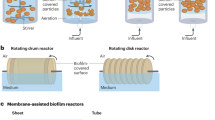Abstract
A stainless steel paper-embedded biofilm reactor (PEBR) was developed for Candida spp. growth, permitting confluent distribution of nutrients by capillary diffusion through ordinary laboratory filter paper. Antibiogram disks were distributed along the filter paper rim, and the PEBR received 0.1 or 0.01 % crystal violet (CV) at 200 μL min−1 and at 37 °C, for 48 h. CV was recovered from the disks and measured at 540 nm. Candida albicans SC5314 cells were applied onto antibiogram disks. The bioreactor was assembled, and YEPD broth was admitted (200 μL min−1) at 37 °C, for 72 h. Biofilm growth was estimated via the MTT reduction test. Controls were disks that received the same treatments, except for the fungus. The PEBR was considered high-throughput table, low-cost, and feasible to grow C. albicans biofilms.






Similar content being viewed by others
References
Taff HT, Nett JE, Zarnowski R, Ross KM, Sanchez H, Cain MT, Hamaker J, Mitchell AP, Andes DR. A Candida biofilm-induced pathway for matrix glucan delivery: implications for drug resistance. PLoS Pathog. 2012;8(8):e1002848.
Vialás V, Perumal P, Gutierrez D, Ximénez-Embún P, Nombela C, Gil C, Chaffin WL. Cell surface shaving of Candida albicans biofilms, hyphae, and yeast form cells. Proteomics. 2012;12:2331–9.
Mendes A, Mores AU, Carvalho AP, Rosa RT, Samaranayake LP, Rosa EA. Candida albicans biofilms produce more secreted aspartyl protease than the planktonic cells. Biol Pharm Bull. 2007;30:1813–5.
Baboni FB, Guariza Filho O, Moreno AN, Rosa EA. Influence of cigarette smoke condensate on cariogenic and candidal biofilm formation on orthodontic materials. Am J Orthod Dentofac Orthop. 2010;138:427–34.
Thein ZM, Samaranayake YH, Samaranayake LP. In vitro biofilm formation of Candida albicans and non-albicans Candida species under dynamic and anaerobic conditions. Arch Oral Biol. 2007;52:761–7.
McCoy WF, Costerton JW. Fouling biofilm development in tubular flow systems. Dev Ind Microbiol. 1982;23:551–8.
Ramage G, Wickes BL, López-Ribot JL. A seed and feed model for the formation of Candida albicans biofilms under flow conditions using an improved modified Robbins device. Rev Iberoam Micol. 2008;25:37–40.
De Prijck K, De Smet N, Coenye T, Schacht E, Nelis HJ. Prevention of Candida albicans biofilm formation by covalently bound dimethylaminoethylmethacrylate and polyethylenimine. Mycopathologia. 2010;170:213–21.
Bernhardt H, Knoke M, Bernhardt J. Efficacy of anidulafungin against biofilms of different Candida species in long-term trials of continuous flow cultivation. Mycoses. 2011;54:e821–7.
Carlson RP, Taffs R, Davison WM, Stewart PS. Anti-biofilm properties of chitosan-coated surfaces. J Biomater Sci Polym Ed. 2008;19:1035–46.
Uppuluri P, Chaturvedi AK, Lopez-Ribot JL. Design of a simple model of Candida albicans biofilms formed under conditions of flow: development, architecture, and drug resistance. Mycopathologia. 2009;168:101–9.
Uppuluri P, Lopez-Ribot JL. An easy and economical in vitro method for the formation of Candida albicans biofilms under continuous conditions of flow. Virulence. 2010;1:483–7.
Gottschamel J, Richter L, Mak A, Jungreuthmayer C, Birnbaumer G, Milnera M, Brückl H, Ertl P. Development of a disposable microfluidic biochip for multiparameter cell population measurements. Anal Chem. 2009;81:8503–12.
Hawser SP, Douglas LJ. Biofilm formation by Candida species on the surface of catheter materials in vitro. Infect Immun. 1994;62:915–21.
Synnott JM, Guida A, Mulhern-Haughey S, Higgins DG, Butler G. Regulation of the hypoxic response in Candida albicans. Eukaryot Cell. 2010;9:1734–46.
Grahl N, Shepardson KM, Chung D, Cramer RA. Hypoxia and fungal pathogenesis: to air or not to air? Eukaryot Cell. 2012;11:560–70.
Rosa EA, Rached RN, Ignácio SA, Rosa RT, José da Silva W, Yau JY, Samaranayake LP. Phenotypic evaluation of the effect of anaerobiosis on some virulence attributes of Candida albicans. J Med Microbiol. 2008;57:1277–81.
Rymovicz AU, Souza RD, Gursky LC, Rosa RT, Trevilatto PC, Groppo FC, Rosa EA. Screening of reducing agents for anaerobic growth of Candida albicans SC5314. J Microbiol Methods. 2011;84:461–6.
Ruy F, Vercesi AE, Kowaltowski AJ. Inhibition of specific electron transport pathways leads to oxidative stress and decreased Candida albicans proliferation. J Bioenerg Biomembr. 2006;38:129–35.
Ogasawara A, Odahara K, Toume M, Watanabe T, Mikami T, Matsumoto T. Change in the respiration system of Candida albicans in the lag and log growth phase. Biol Pharm Bull. 2006;29:448–50.
Patil S, Deshmukh V, Renukdas S, Patel N. Kinetics of adsorption of crystal violet from aqueous solutions using different natural materials. Int J Environ Sci. 2011;1:1116–34.
Pettit RK, Weber CA, Pettit GR. Application of a high throughput Alamar blue biofilm susceptibility assay to Staphylococcus aureus biofilms. Ann Clin Microbiol Antimicrob. 2009;8:28.
Kim J, Hegde M, Kim SH, Wood TK, Jayaraman A. A microfluidic device for high throughput bacterial biofilm studies. Lab Chip. 2012;12:1157–63.
Kim J, Park HD, Chung S. Microfluidic approaches to bacterial biofilm formation. Molecules. 2012;17:9818–34.
Acknowledgments
This study was granted by the Brazilian research agency Araucaria Foundation (Proc. 11524, Conv. 416/2009). Authors thank the cooperation of professors and technicians from the Electron Microscopy Centre and the Confocal Laboratory Facility of Federal University of Paraná.
Conflict of interest
Authors declare having no conflict of interest of any order.
Author information
Authors and Affiliations
Corresponding author
Rights and permissions
About this article
Cite this article
Selow, M.L.C., Rymovicz, A.U.M., Ribas, C.R. et al. Growing Candida albicans Biofilms on Paper Support and Dynamic Conditions. Mycopathologia 180, 27–33 (2015). https://doi.org/10.1007/s11046-015-9889-y
Received:
Accepted:
Published:
Issue Date:
DOI: https://doi.org/10.1007/s11046-015-9889-y




